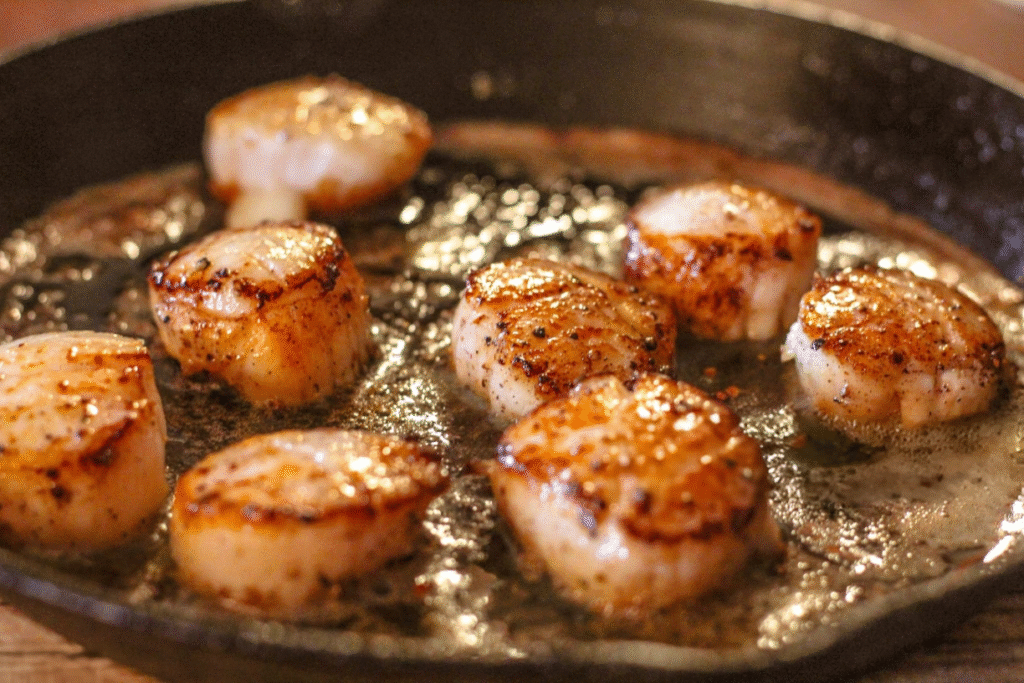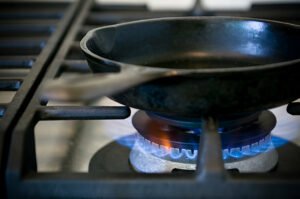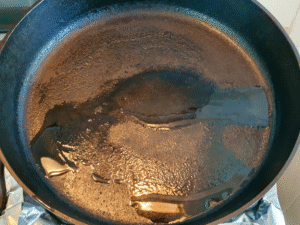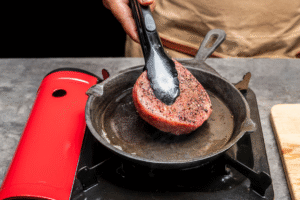How I get steak-house crust at home—and why the physics of iron beats fancy coatings every time.

The first time I seared scallops in cast iron, I held my breath—three plump medallions hissing in a halo of butter, the kitchen filling with sweet-briny steam. In sixty heart-pounding seconds, the undersides turned caramel-brown, smelling like the ocean meeting toasted sugar. When I slid them onto my tongue, the crust shattered and a surge of silky warmth followed, and I realized this humble, heavy pan could turn fragile seafood into pure magic. If you’ve ever chased that perfect golden edge—and the pride that blooms when you nail it—stick with me. Your stove, your skillet, and a little science are about to make dinner unforgettable.
Why I Reach for Cast Iron First
There’s a moment every home cook knows: you set a steak on a ripping-hot pan, wait for that first hiss, then peek under the edge to check the crust. With cast iron, that bronze-brown sear shows up fast—and it sticks around through the entire cook. The secret isn’t nostalgia or folklore; it’s science and smart design. In this post I’ll show you:
- The heat physics that keep cast iron hotter than aluminum or stainless.
- How seasoning turns bare iron into a natural non-stick surface.
- Step-by-step searing techniques you can master tonight.
- A comparison table of today’s top skillets (yes, including a few affiliate picks for budget shoppers).
- Practical care tips so your pan outlives you and your kids.
By the end, you’ll know exactly why cast iron earns prime real estate on my stovetop—and how you can squeeze maximum flavor out of one skillet for life.
Disclosure: This post contains affiliate links. If you click through and make a purchase, we may earn a small commission at no additional cost to you. Please read our Affiliate Disclosure for more information.
The Science Behind the Sear
Heat Capacity & Retention
Cast iron has a higher heat capacity than copper or aluminum, meaning it takes more energy to cool it down when you drop a cold steak on the surface. That thermal mass keeps temperatures steady, prevents steaming, and lets the Maillard reaction race ahead .
Conductivity Caveats—and the Power of Preheating
Iron’s Achilles’ heel is low conductivity: the pan heats slowly and forms hot spots if the burner is smaller than the base . I solve this by:
- Choosing a burner that covers at least 75 % of the pan.
- Preheating five to ten minutes on medium until a water drop skitters and vanishes.
- Nudging the heat just above medium-high right before food hits.
Patience here pays off with an even crust later.
Flavor Chemistry: The Maillard Reaction
At roughly 280 °F (138 °C), proteins and sugars reorganize into hundreds of new flavor compounds—we call it the Maillard reaction . Cast iron’s relentless heat means that reaction doesn’t stall out when you lay down a thick chop. For more information on the Maillard Reaction, check out my guide for nerdy details on pH, moisture, and crust formation.
Seasoning: Nature’s Non-Stick Chemistry
What Seasoning Really Is
When you coat iron with a thin layer of flaxseed or grapeseed oil and bake it, the unsaturated fats polymerize—literally turning into a plastic-like matrix that locks into microscopic pores . Each fry session layers on more polymer, smoothing rough spots until eggs slide out with nothing but a wipe.
Safe & Natural vs. PTFE
Unlike commercial non-stick coatings containing synthetic chemicals such as PTFE or older formulations with PFOA, seasoned iron uses nothing but hardened cooking oil . Less worry about flaking coatings, more freedom to blast heat for that steak crust.
Pro tip: Bake on three very thin coats of oil at 450 °F, letting each one smoke and go matte before the next.
Choosing the Right Cast-Iron Skillet
Size, Weight, and Stove Fit
A 10- to 12-inch skillet covers most stovetop burners and fits a whole chicken spatchcocked flat. Classic designs weigh 5–8 lbs; if that’s tough on your wrists, look for lightweight options from brands like Smithey or Victoria that shave a pound while staying sturdy .
Today’s Top Pans—A Quick Comparison
| Brand & Model | Weight | Pre-seasoned? | Oven-Safe Temp | Notable Perk | My Use-Case |
| Lodge 10.25-in Skillet | 5.2 lb | Yes | 500 °F | Cheapest workhorse | Daily steak & cornbread |
| Smithey No. 12 | 7 lb | Yes | 550 °F | Polished interior | Show-piece searing |
| Victoria 12-in Light | 6 lb | Yes | 475 °F | Lighter weight | One-pan family dinners |
| Le Creuset Enamel | 7.5 lb | Enamel | 500 °F | No seasoning upkeep | Acidic sauces |
My Foolproof Searing Method
- Preheat the dry skillet on medium for 8 minutes.

- Pat your protein dry and season simply with kosher salt. Moisture is the enemy of crust.
- Film of oil: Add 1 tsp of high-smoke-point oil, swirl to shimmer.

- Sear undisturbed for 90 seconds. Flip only when the edges release easily.

- Finish: For thick cuts, slide the skillet into a 400 °F oven until internal temp is 10 °F shy of target; carry-over will handle the rest.
- Rest on a wire rack 5 minutes before slicing.
Common Mistakes I See
- Overcrowding (results in steaming).
- Skipping the preheat.
- Washing with soap that isn’t fully rinsed—residual surfactant kills seasoning.
Everyday Versatility Beyond Steak
Because cast iron is oven-safe to at least 500 °F and happy over a campfire, I use the same pan for:
- Crunchy-edged cornbread.
- Shallow-fried chicken thighs.
- Charred Brussels sprouts finished with balsamic.
- Breakfast hash that goes straight from burner to broiler for a cheesy top.
Serious Eats even rates the classic Lodge as the best cast-iron skillet for most cooks thanks to that all-terrain durability.
Caring for Your Skillet so It Lasts a Lifetime
- Wipe or scrub with coarse salt and a dab of water while the pan is still warm.
- Dry on the burner until no steam rises.
- Oil lightly (½ tsp), then heat 1 minute until just smoking; wipe excess.
- Store with the lid off to avoid trapped moisture.
Need more detail? The folks at Eckert’s Farm have a thorough care walkthrough.
Key Takeaways
- High heat capacity keeps temperatures stable for perfect sears.
- Seasoning builds a safe, natural non-stick finish—no PTFE flaking.
- Proper preheating and burner fit offset iron’s slow conductivity.
- One skillet handles stovetop, oven, grill, and campfire without flinching.
- With minimal upkeep, a cast-iron pan can outlive you—and get better every year.
FAQ
Can I use soap on cast iron?
A squirt of mild soap is fine as long as you rinse and re-oil afterward. Modern detergents are gentler than old lye-based soaps.
Why does my pan feel sticky after seasoning?
Too much oil. Strip it with hot water and a scrubby, dry thoroughly, and apply thin coats baked at 450 °F.
Is acidic food safe in cast iron?
Quick tomato sauces won’t hurt a well-seasoned pan, but hours-long braises can strip seasoning. Use an enamel-coated skillet for those.
What oil is best for seasoning?
I prefer flaxseed because its high alpha-linolenic acid polymerizes into a hard film.
How do I remove rust?
Scrub with steel wool, rinse, dry, then season again three times. Rust is just iron oxide—cosmetic, not fatal.
Ready to Sear?
Grab that skillet and try the six-step method above. If you need a first pan, click one of the affiliate links in the comparison table—I only recommend gear I cook on myself. Then head over to the Maillard reaction guide to level-up your browning game. Happy cooking!